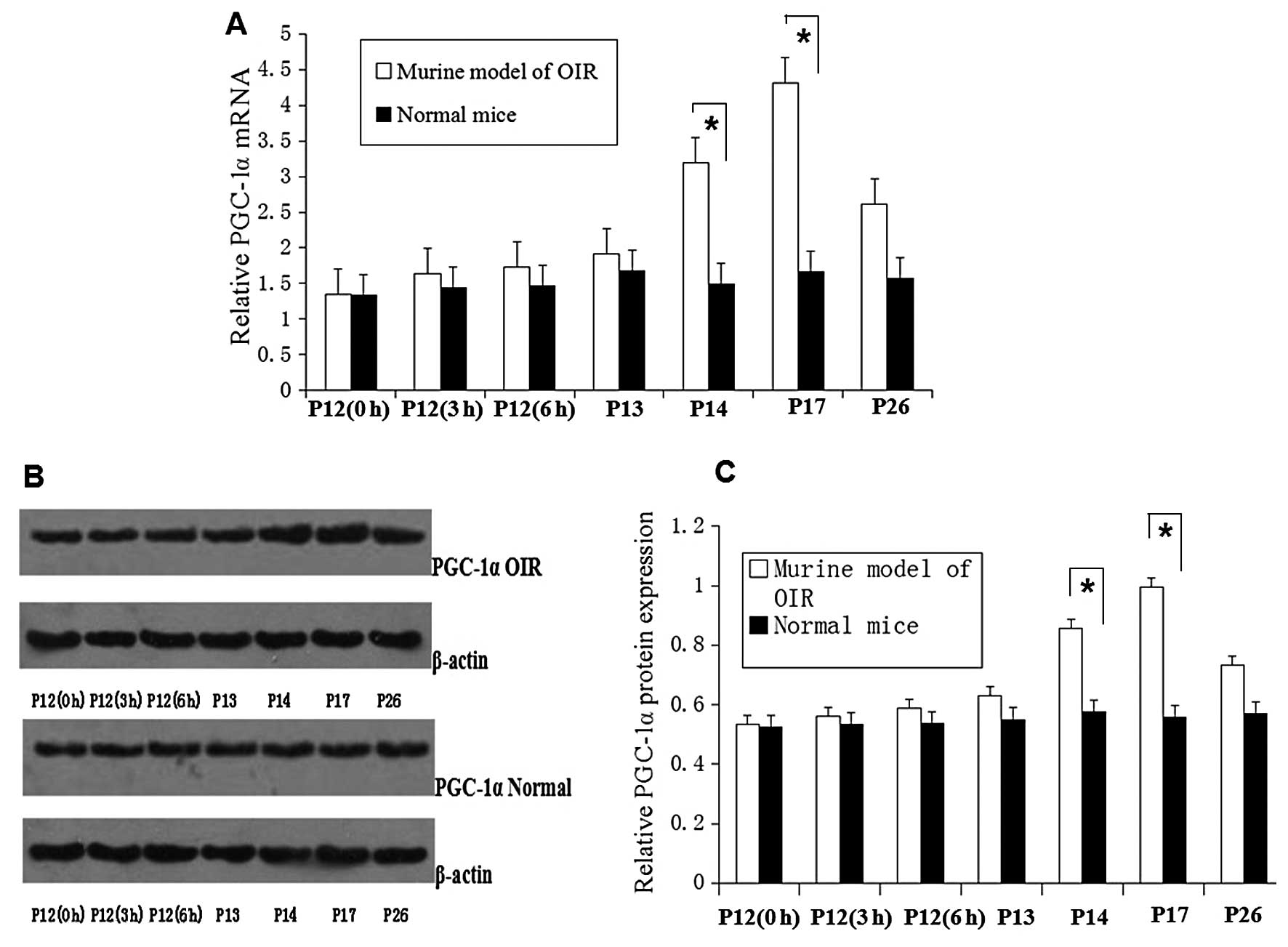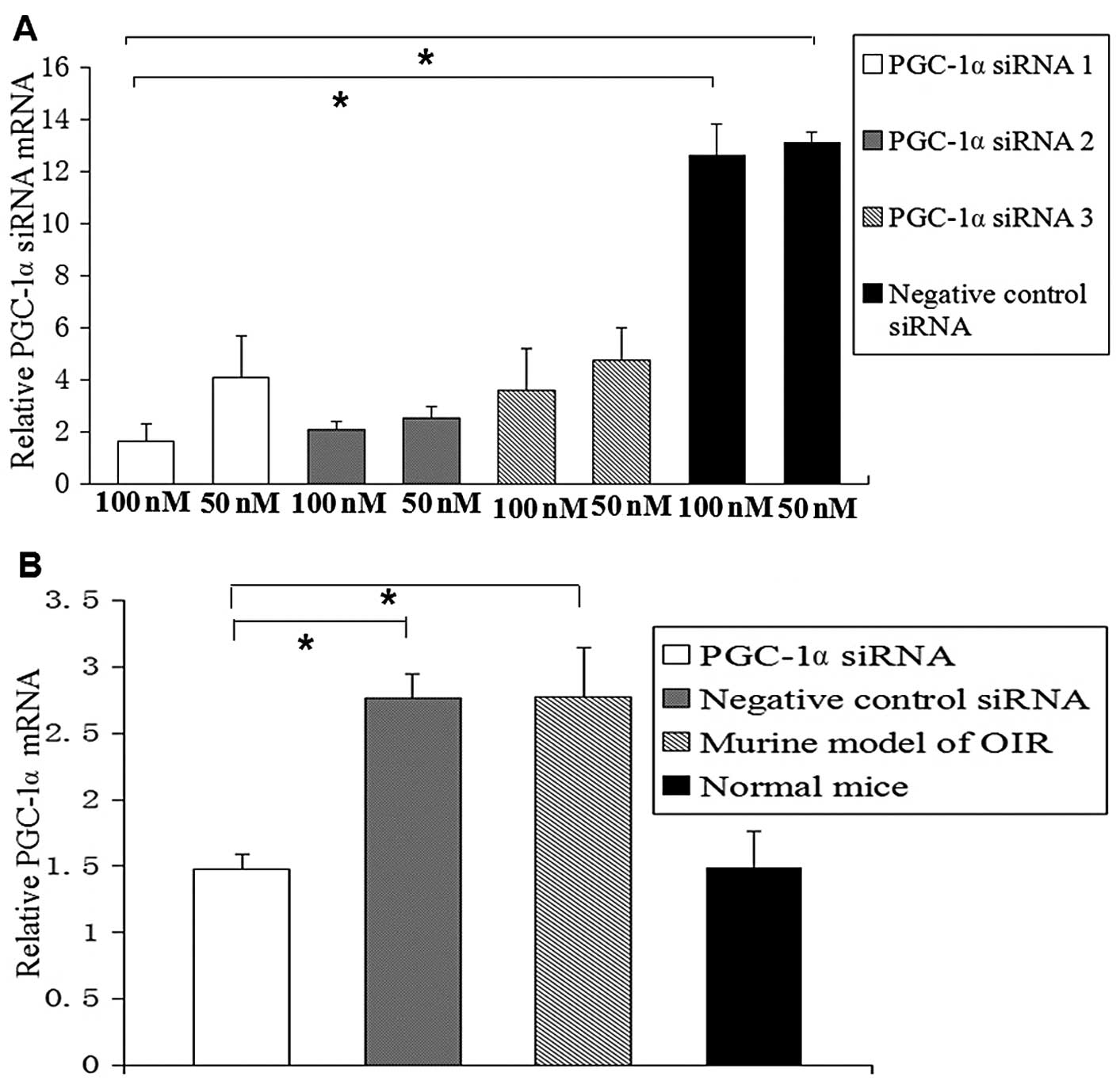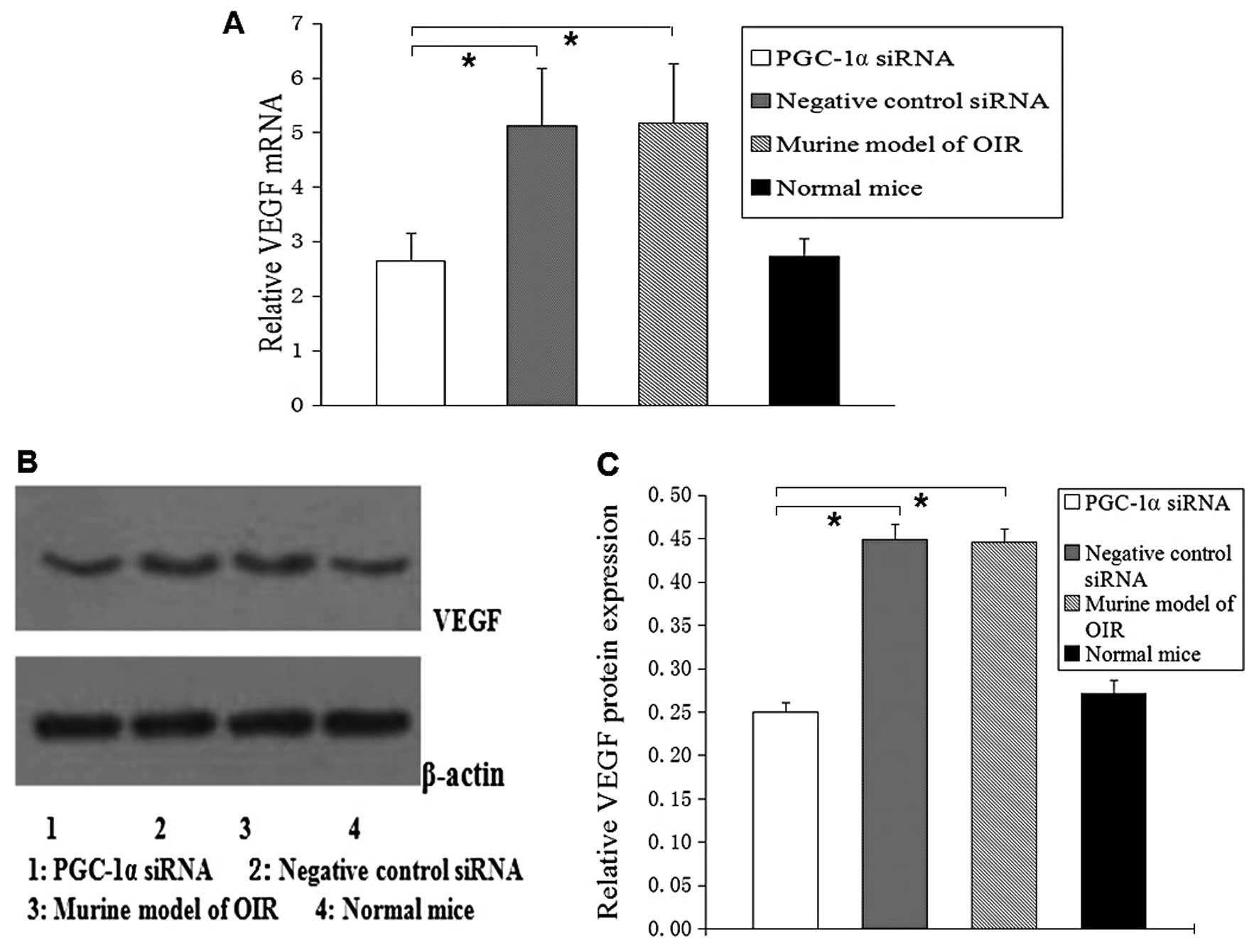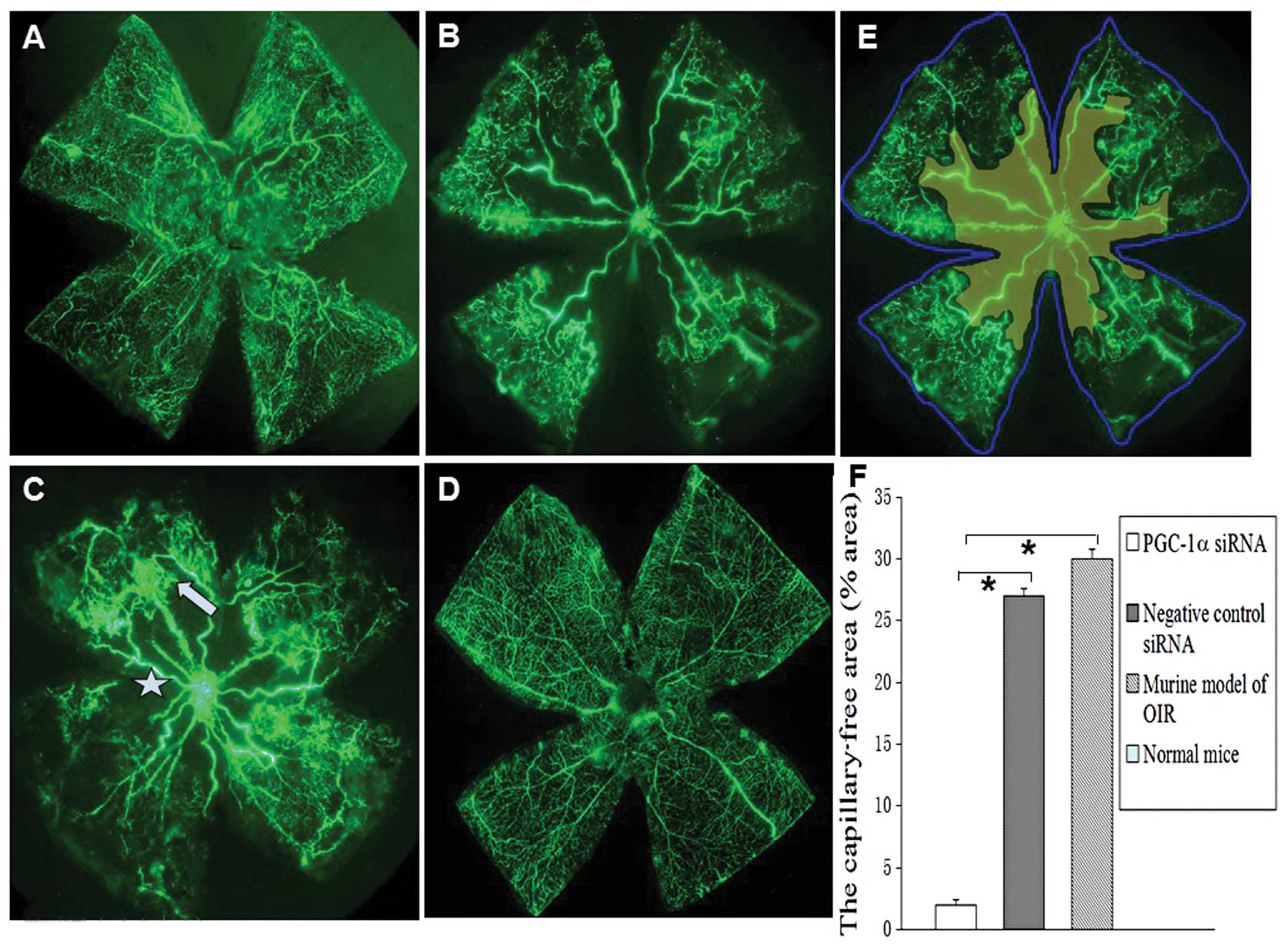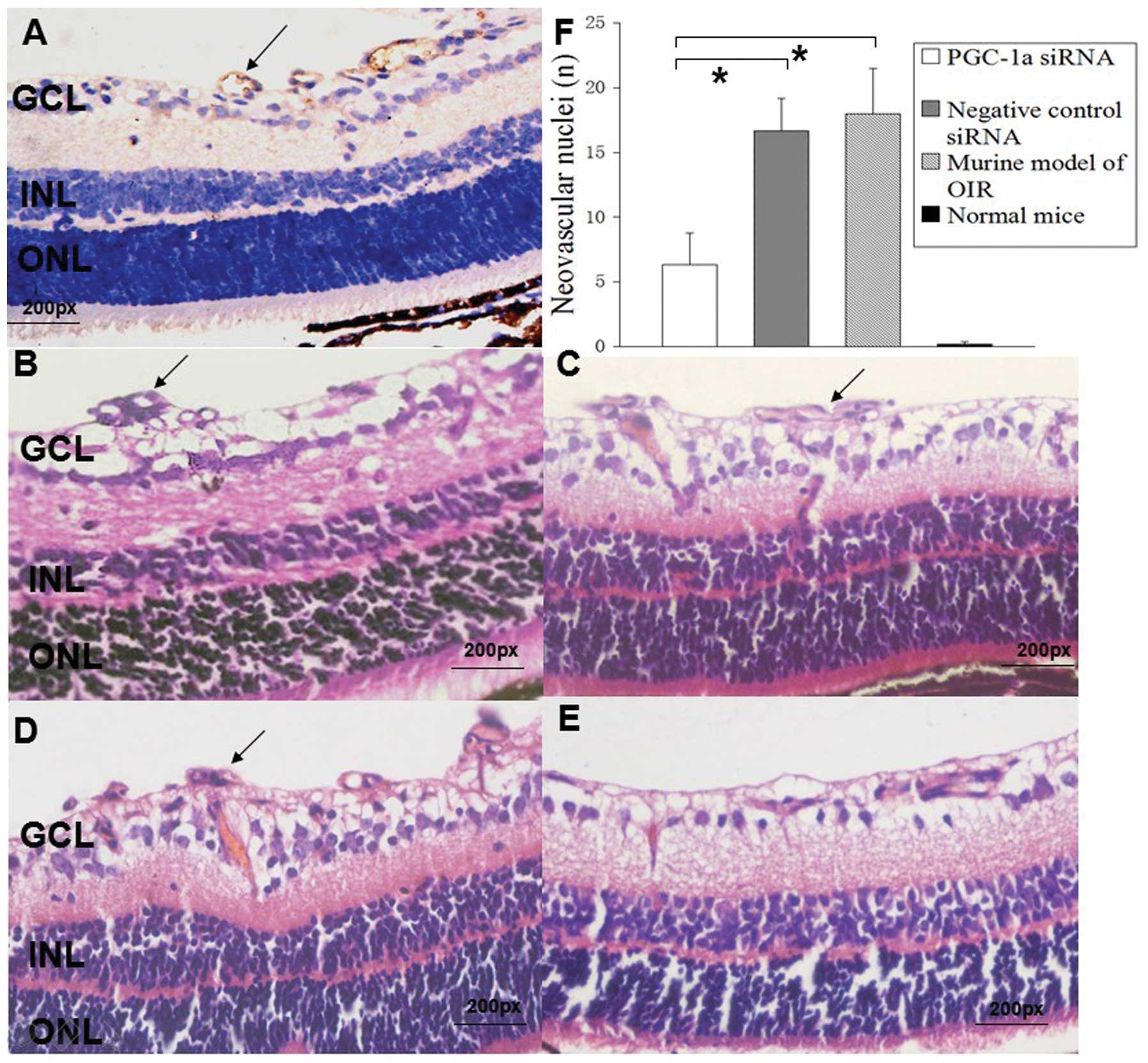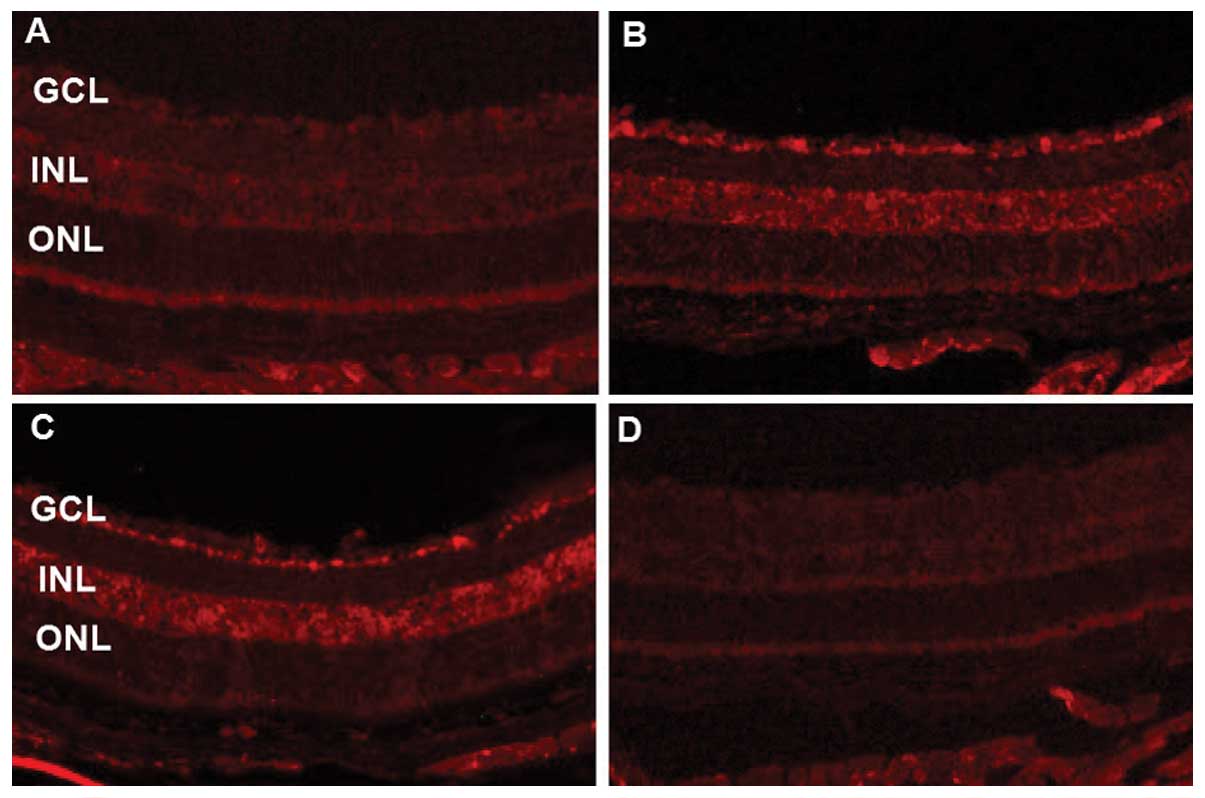Suppression of retinal neovascularization by small interfering RNA targeting PGC-1α
- Authors:
- Published online on: March 31, 2014 https://doi.org/10.3892/ijmm.2014.1717
- Pages: 1523-1530
Abstract
Introduction
Retinal neovascularization is one of the vision-threatening complications of ocular vascular diseases. Recently, the incidence rate of these diseases, such as diabetic retinopathy, central retinal vein occlusion, neovascular glaucoma and retinopathy of prematurity has shown an increasing trend due to the aging of society and the improvement of living conditions (1). A series of events may be involved in the mechanisms of these diseases, such as the degradation of the extracellular matrix components, proliferation and migration of endothelial cells and tube formation. There are a number of angiogenic factors, such as insulin-like growth factor, basic fibroblast growth factor (bFGF), erythropoietin and vascular endothelial growth factor (VEGF), that may be involved in this complex process (2–5). Intensive biochemical and pharmacological studies have focused on anti-VEGF agents, which have been widely used in clinical trials for blocking pathological retinal neovascularization (6). However, the inhibition of VEGF alone cannot completely suppress pathological angiogenesis, as other angiogenic factors, such as hypoxia inducible factor (HIF)-1α (7), erythropoietin (8) and the recently described peroxisome proliferator-activated receptor-γ coactivator-1α (PGC-1α) (9,10) may participate in this pathological process.
PGC-1α is a recently discovered transcriptional coactivator; it belongs to gene families and has a variety of nuclear hormone receptor binding sites, and is involved in cell oxidation reaction and mitochondrial energy metabolism with height adjustment (11). It is abundantly expressed in human and rodent brown adipose tissue, skeletal muscle, the heart, kidneys, liver, brain and vascular endothelial cells (11–14). As is already known, the formation of new blood vessels is closely associated with ischemia and hypoxia. PGC-1α has been confirmed to be involved in the cellular response to tissue hypoxia. As previously demonstrated, under ischemic and hypoxic conditions, PGC-1α expression and transcriptional regulation are significantly enhanced in rat myocardial cells (15,16), the brain (17,18), rabbit renal tubular cells (19) and human skeletal muscle (20). Arany et al (9) demonstrated that PGC-1α upregulates the expression of angiogenic factors, including VEGF, and promotes neovascularization. Thus, another important function of PGC-1α in a hypoxic environment is to stimulate the formation of new blood vessels. Hypoxia upregulates PGC-1α expression, then stimulates the expression of VEGF, and this process does not require the participation of HIF-1 (9,21). Therefore, PGC-1α may be a novel therapeutic target in hypoxic or ischemic disease (22).
In this study, we demonstrate the expression of PGC-1α in the retina and the upregulation of PGC-1α under hypoxic conditions in the retina. We hypothesized that PGC-1α is involved in the regulation of pathological retinal neovascularization and may play a role in promoting pathological retinal neovascularization. Therefore, we aimed to determine whether PGC-1α plays such a role and to elucidate the molecular mechanisms of the regulation of pathological retinal neovascularization by PGC-1α. In order to confirm our hypothesis, we investigated the effects of small interfering RNA (siRNA) targeting PGC-1α on PGC-1α and VEGF mRNA and protein expression and retinal neovascularization in a murine model of oxygen-induced retinopathy (OIR).
Materials and methods
siRNA design
The selection of siRNAs was based on the characterization of siRNA by Elbashir et al (23). Three siRNAs targeting mouse PGC-1α mRNA (PGC-1α siRNA1–3) were designed. The sense strand of PGC-1α siRNA1 was 5′-CCAA GACUCUAGACAACUAdTdT-3′, and the antisense strand was 3′-dTdTGGUUCUGAGAUCUGUUGAU-5′. The sense strand of PGC-1α siRNA2 was 5′-GCAACAUGCUCAAG CCAAAdTdT-3′, and the antisense strand was 3′-dTdTCGUU GUACGAGUUCGGUUU-5′. The sense strand of PGC-1α siRNA3 was 5′-CUGCGAACAUUUUGAGAAdTdT-3′, and the antisense strand was 3′-dTdTGACGCUUGUAUAAAC UCUU-5′. One negative control siRNA which has limited homology to sequences in the human and mouse genomes and 3 PGC-1α siRNAs were synthesized and purified by a siRNA company (RiboBio, Guangzhou, China). In order to find the most effective siRNA, we transfected these 3 siRNAs into vascular endothelial cells using Lipofectamine 2000 (Invitrogen, Carlsbad, CA, USA). Real-time polymerase chain reaction (PCR) was used to evaluate the efficacy of the siRNAs in downregulating PGC-1α expression in the cells. The PGC-1α siRNA which had the best inhibitory effect on PGC-1α mRNA expression would be the one used in the following experiments.
Cell culture and transfection
Mouse retinal vascular endothelial cells (MIC-CELL-0055; PriCells, Wuhan, China) were cultured in DMEM supplemented with 10% fetal bovine serum and 1% penicillin-streptomycin in a humidified incubator containing 5% CO2 at 37°C. The transfection reagent, Lipofectamine 2000 (Invitrogen), was used to transfect PGC-1α siRNA into the retinal vascular endothelial cells according to the manufacturer’s instructions (Invitrogen).
Animal model
All animal experiments were carried out in accordance with the Association for Research in Vision and Ophthalmology (ARVO) Statement for the Use of Animals in Ophthalmic and Vision Research. The murine model of OIR was created as previously described (24). Briefly, C57BL/6J mice (purchased from Shanghai Laboratory Animal Center, Chinese Academy of Sciences, Shanghai, China) were exposed to 75±2% oxygen for 5 days from day 7 after birth [post-natal day (P)7] with nursing mothers. On P12, the mice were removed from the hyperoxic environment and maintained under normal conditions until P17. Age-matched C57BL/6J mice maintained under normal oxygen conditions were used as the controls. The mice were randomly divided into a normal group, an OIR group (murine model of OIR), a negative control siRNA group and a PGC-1α siRNA group.
Assessment of PGC-1α expression in the retinas of mice with OIR
Mice with OIR and normal (healthy) mice were sacrificed on P12 (0, 3 and 6 h), P13, P14, P17 and P26. An equal number of mice (n=5) was used at each time point; the eyes were enucleated and the total RNA and protein from the retinas were extracted. PGC-1α expression was detected by real-time PCR and western blot analysis.
Intravitreal injection
On P12, the mice (n=5 per group) were anesthetized by an intraperitoneal injection of 1% pentobarbital sodium (0.01 ml, 30 mg/kg body weight). The lid fissure was opened using a scalpel blade. A 32-gauge Hamilton needle and syringe were used to deliver 1 μl liposome-PGC-1α siRNA (2.5 μg) complex (PGC-1α siRNA group) or 1 μl control complex (liposome-negative control siRNA; negative control siRNA group) into the vitreous cavity. The eye was then repositioned and the lids were approximated over the cornea. Mice were returned to room air at P12.
Fluorescein angiography
On P17, mice (n=5/each group) from each group were deeply anesthetized and then perfused through the left ventricle with 1 ml of phosphate-buffered-saline (PBS) containing 50 mg fluorescein-conjugated dextran (Sigma, St. Louis, MO, USA). The eyes were then enucleated and fixed in 4% paraformaldehyde for 20 min. The retinas were dissected to remove the cornea, lens, sclera and placed in 4% paraformaldehyde for a further 5 min. The retina was cut in 4 places at the peripheral area and flat-mounted on the microscope slides with antifade solution. We analyzed the retinal size of the non-perfusion area by using the method of pixel detection of teh non-perfusion area and the whole area of the retina, as previously described (25,26). Images were analyzed using Photoshop software (Adobe Systems, Mountain View, CA, USA). The results are expressed as (non-perfusion area/total area) ×100%.
Real-time PCR
Total RNA was extracted and 1 μg template was reverse-transcribed using the RevertAid™ First-Strand cDNA synthesis kit from MBI Biosystems (Fermentas, Copenhagen, Denmark). Each RNA sample was obtained from 2 retinas. Real-time PCR was performed on a 7900HT Fast Real-Time PCR System apparatus (Applied Biosystems, Foster City, CA, USA) using SYBR Premix Ex Taq™ (Takara Bio, Inc., Shiga, Japan). The sequences of the PGC-1α (mouse) primers were: 5′-AGCAGAAAGCAATTGAAGAG-3′ (sense) and 5′-AGG TGTAACGGTAGGTGATG-3′ (antisense) 171 bp. The sequences of the β-actin (mouse) primers were: 5′-TTCCTTC TTGGGTATGGAAT-3′ (sense) and 5′-GAGCAATGATCTT GATCTTC-3′ (antisense) 203 bp. The sequences of the VEGF (mouse) primers were: 5′-CATCTTCAAGCCGTCCTGT-3′ (sense) and 5′-GAG GAAAGGGAAAGGGTCA-3′ (antisense) 240 bp. Thermal cycling conditions were as follows: 5′ at 95°C; 40 cycles of 20 sec at 94°C, 20 sec at 57–60°C, 20 sec at 72°C.
Western blot analysis
The murine retinas were collected and lysed in lysis buffer (150 mM NaCl, 50 mM Tris-HCl, pH 7.4, 2 mM EDTA and 1% NP-40) (Beyotime, Shanghai, China) containing protease inhibitors (Boehringer, Mannheim, Germany). Each protein sample was obtained from 4 retinas. Total protein was resolved by SDS polyacrylamide gel electrophoresis and was then transferred onto a nitrocellulose membrane (Millipore, Billerica, MA, USA). The membrane was incubated with rabbit polyclonal anti-mouse PGC-1α antibody (1:500 dilution; Abcam, Cambridge, MA, USA) or monoclonal anti-mouse VEGF antibody (1:200 dilution; Abcam) and monoclonal anti-mouse β-actin (1:10,000 dilution; Santa Cruz Biotechnology, Inc., Santa Cruz, CA, USA). Peroxidase-conjugated secondary antibodies (1:2,000 dilution; Abcam) were used as secondary detection reagents with an enhanced chemiluminescence kit (GE Healthcare, New York, NY, USA). Chemiluminescent signals were visualized by exposure to X-ray film (Kodar, Rochester, NY, USA). Band intensities were quantified using BandScan software (version 5.0). The expression levels of β-actin were used for standardization. The results are expressed as the ratio of PGC-1α/β-actin or VEGF/β-actin.
Histological analysis of neovascularization
Hematoxylin and eosin (H&E)
At P17, mice (n=5/each group) from each group were sacrificed by an intraperitoneal injection of an overdose of sodium pentobarbital. Their eyes were enucleated and fixed with 4% paraformaldehyde in PBS and embedded in paraffin. Serial sections (5 μm) of whole eyes were cut sagittally through the cornea and parallel to the optic nerve, then stained with CD31 antibody (1:50 dilution; Abcam) to mark the endothelial cells lining the blood vessels and stained with H&E to visualize nuclei anterior to the internal limiting membrane. Cross-sections including the optic nerve were excluded. A total of 10 non-serial sections were analyzed per eye. The nuclei above the internal limiting membrane were counted in 400 sections.
Immunofluorescence
The frozen sections were incubated with rabbit polyclonal anti-mouse PGC-1α antibody or monoclonal anti-mouse VEGF antibody at 4°C overnight. Cy3 or Alexa Fluor 488 secondary antibody (1:20; Santa Cruz Biotechnology, Inc.) were used to label the target protein, and microscopic evaluation and photo documentations were performed on a Leica microscope (Leica DFC310 FX; Leica Microsystems, Wetzlar, Germany).
Statistical analysis
Experimental data are expressed as the means ± standard error of the mean (SEM). One-way ANOVA followed by the LSD t-test were used to evaluate significance. A P-value <0.05 was considered to indicate a statistically significant difference.
Results
Upregulation of PGC-1α expression in the retinas of mice with OIR
The mRNA and protein levels of PGC-1α in the retinas of mice were evaluated. The mRNA and protein expression of PGC-1α was significantly (P<0.05) upregulated in the retinas of mice with OIR at P17 compared with the normal mice group ( Fig. 1). The mRNA and protein levels of PGC-1α were upregulated at P14, reaching a peak at P17 and were significantly increased by approximately 2-fold compared with the normal (healthy) mice (P<0.05; Fig. 1A and C).
Suppression of PGC-1α expression in vitro and in vivo by PGC-1α siRNA
We found that the 3 designed siRNAs suppressed PGC-1α expression to a different extent. PGC-1α siRNA1 was found to be the most efficient siRNA (Fig. 2A). Therefore, PGC-1α siRNA1 was used in the intravitreal injection. The PGC-1α mRNA level in the PGC-1α siRNA1-transfected cells was markedly decreased compared with the cells transfected with the negative control siRNA (P<0.05). Real-time PCR and western blot analysis were also used to detect PGC-1α mRNA and protein levels in vivo. We found that the PGC-1α mRNA level was significantly downregulated by 54%, and the protein level was downregulated by 53% following the intravitreal injection of PGC-1α siRNA1 compared with the murine model of OIR and the negative control siRNA group (P<0.05; Fig. 2B–D).
Concomitant downregulation of the VEGF expression by PGC-1α siRNA
We analyzed the levels of VEGF mRNA and protein in the retinas of mcie by real-time PCR and western blot analysis. Following the intravitreal injection of PGC-1α siRNA1, we found that the level of VEGF mRNA decreased by 48% (P<0.05; Fig. 3A) and the level of VEGF protein decreased by 40% (P<0.05; Fig. 3B and C), compared with the murine OIR model and the negative control siRNA group.
Angiographic evaluation of the effects of PGC-1α siRNA on retinal neovascularization
To evaluate the angiostatic efficacy of PGC-1α siRNA on oxygen-induced retinal neovascularization, the retinas were examined by fluorescein-dextran perfusion and flat-mounted on P17. No mice used in this study developed signs of infection and retinal detachment. The retinas of the room-air-raised mice revealed superficial and deep vascular layers that extended from the optic nerve to the periphery. Fewer neovascular complexes were observed in the retinas of the eyes of mice injected with PGC-1α siRNA1 (Fig. 4A). However, retinas from the hyperoxia-exposed mice injected with the negative control siRNA or from the mice not injected with siRNA contained multiple neovascular tufts and a central non-perfusion area (Fig. 4B and C). By contrast, the vessels formed a fine radial branching pattern in the superficial retinal layer and a polygonal reticular pattern in the deep retinal layer, without neovascular tufts (Fig. 4D). Areas of non-perfusion (yellow), as well as the total retinal area (blue line) were measured (Fig. 4E). The area ratio of the retinal non-perfusion area and total area of the murine model of OIR was 30±0.6%, in the negative control siRNA group it was 27.1±0.8%, while in the PGC-1α siRNA group (2.4±0.4%) it decreased significantly compared with mice with OIR and the negative control siRNA group (*P<0.05). No obvious non-perfusion area was observed in the normal group (Fig. 4F).
Histological analysis of retinal neovascularization
As shown in (Fig. 5B–F), there were no neovascular nuclei in the normal group (n=100 slices); however, the average number of neovascular nuclei were 18.0±3.5 in the non-injected eyes exposed to hyperoxic conditions (n=100 slices), 16.7±2.5 in the eyes injected with the negative control siRNA (n=100 slices) and 6.3±2.5 in the eyes injected with PGC-1α siRNA1 (n=100 slices). There was a significant reduction in retinal neovascularization in the PGC-1α siRNA group, approximately 65% (P<0.05).
To further confirm the inhibitory effects of PGC-1α siRNA on angiogenesis, immunofluorescence analysis was performed and the results indicated that PGC-1α and VEGF expression was were downregulated by PGC-1α siRNA1 compared with the mice with OIR (Fig. 6A–D and E–H). PGC-1α and VEGF expression was mainly observed in the ganglion cell layer and inner nuclear layer and was reduced mainly in the ganglion cell layer following the local administration of PGC-1α siRNA compared with the mice with OIR (murine model of OIR).
Discussion
Retinal neovascularization, the abnormal formation of new vessels from pre-existing capillaries in the retina, is a common complication of many ocular diseases, such as advanced diabetic retinopathy or retinopathy of prematurity. Neovascularization can lead to fibrosis and the disruption of delicate tissues required for vision (24). Although some orthodox treatments are effective in the suppression of angiogenesis in short term, they are also destructive to the retinal tissue, which lead to immediate and sometimes significant loss of vision. Therefore, therapy based on the molecular mechanisms of retinal neovascularization provides a potential for a more effective treatment.
In this study, in the mouse model of OIR, the retinal vasculature initially underwent reversible central vasoconstriction followed by non-perfusion on P7 when exposed to hyperoxia, then more peripheral vessels were spared, a small avascular zone appeared at the ora serrata, larger central radial vessels became tortuous and engorged on P14, and retinal neovascularization occurred extensively during P17 and P21 (8). In this study, the mRNA and protein expression of PGC-1α was highly upregulated in the retinas of the mice with OIR on P17 compared with the controls. The strong expression of PGC-1α was detected in the retinas of mice with OIR by immunofluorescence, which was mainly localized in the ganglion cell layer and inner nuclear layer. Furthermore, PGC-1α expression was observed in the areas of where neovascular vessels had broken through the inner limiting membrane. Therefore, PGC-1α is involved in retinal neovascularization and its upregulation may promote angiogenesis.
RNA interference (RNAi) is a sequence-specific RNA degradation process that is conserved in eukaryotes and mediates target-specific RNA sequence degradation through a double-stranded RNA-induced silencing complex (27). Recently, the RNAi pathway has become the predominant means of assessing loss of gene function in many organisms (28,29). The remarkable utility of siRNA in modulating gene expression has resulted in an explosion of interest in deciphering the molecular mechanisms that control this pathway and imaginative ideas of ways to apply it to research and clinical settings (30,31). In our stuty, in order to determine the most prominent inhibitory effect of PGC-1α siRNA, 3 sequences (PGC-1α siRNA1-3) were designed and synthesized. The results revealed that all 3 siRNAs suppressed PGC-1α expression to a different extent. The most significant inhibitory effect was observed with PGC-1α siRNA1, which inhibited the expression of PGC-1α by 80% in the cultured cells.
In this study, we found that retinal neovascularization was inhibited by 65% by counting the number of endothelial cell nuclei protruding into the vitreous cavity in the murine model of OIR following the injection of PGC-1α siRNA1 (2.5 μg). Retinal neovascularization and non-perfused areas were markedly reduced by PGC-1α siRNA transfection in the model of OIR. Moreover, the number of new vessels and endothelial cells protruding into the inner limiting membrane in the retinas treated with PGC-1α siRNA was also significantly reduced. PGC-1α mRNA and protein levels in the retinas were also significantly downregulated by PGC-1α siRNA. We speculated that PGC-1α exerts its functions in pathological angiogenesis through two possible mechanisms. Firstly, the localization where PGC-1α siRNA was distributed in the retina was close to the site of hypoxia-induced PGC-1α generation; it increased gene expression in a particular layer of the retina (either the ganglion cell layer or inner nuclear layer). We demonstrated that intravitreally injected siRNA rapidly accessed the internal limiting membrane and entered the inner retinal cells, which was consistent with the results of a previous study (32). Therefore, intravitreally injected PGC-1α siRNA can be carried successfully into retinal cells, which are responsible for producing hypoxia-induced PGC-1α. Secondly, the catalytic nature of RNAi was another reason. PGC-1α siRNA which was absorbed by the retinal cells can bind to the RNA-induced silencing complex (RISC), which in turn becomes activated. The activated RISC complex seeks the PGC-1α mRNA and then splices the mRNA at the site of the homologous sequence (33). Furthermore, in a multiple turnover kinetic manner, the activated RISC can seek another PGC-1α mRNA to bind and destroy. One activated RISC complex can bind and destroy hundreds of PGC-1α mRNA. Therefore, the local administration of a small amount of PGC-1α siRNA is an effective approach for suppressing retinal neovascularization.
VEGF is considered the primary factor that leads to angiogenesis in the retina. VEGF promotes the recruitment of endothelial precursor cells into the circulation during local hypoxia and the proliferation of resident retinal vasculature to respond to ischemic injury (34,35). During the past decade, relevant clinical trials emphasizing on inhibitors of the VEGF signaling pathway, have achieved successful attenuation of pathological angiogenesis and have improved the vision of patients (6). However, the regrowth of new vessels often occurs within a few months of the regression of neovascularization after the application of these agents (35). The inhibition of VEGF alone cannot completely suppress pathological angiogenesis, as other angiogenic factors may participate in this pathological process. PGC-1α induces the expression of VEGFA in numerous retinal cells, and PGC-1α expression is strongly induced during post-natal retinal development, coincident with VEGFA expression and angiogenesis (10). In this study, the mRNA and protein expression of VEGF were both downregulated following the administration of PGC-1α siRNA in the mouse model of OIR. VEGF expression was mainly observed in the ganglion cell layer and inner nuclear layer and was reduced mainly in the ganglion cell layer following the local administration of PGC-1α siRNA. The data presented in this study demonstrate that PGC-1α siRNA downregulates the expression of PGC-1α, which then reduces the expression of VEGF through the PGC-1α-VEGF signaling pathway, finally inhibiting neovascularization. Therefore, PGC-1α regulates the expression of VEGF in the retina, particularly in ganglion cells. Under hypoxic conditions, VEGF can be regulated by not only PGC-1α, but also by HIF-1α (36). The regulation of VEGF by PGC-1α is HIF-independent (9). In additoin, there are other angiogenic factors, such as platelet-derived growth factor-B (PDGF-B), angiopoietin-2 (Ang2) and bFGF regulated by PGC-1α (9,37). Therefore, we hypothesized that the suppression of PGC-1α may enhance other signaling pathways to promote the regrowth of vessels into the central avascular zone from P12 to P17, and reduce non-perfused areas in the model of OIR.
In conclusion, the data presented in this study demonstrate the expression of PGC-1α in the retina and the upregulation of PGC-1α under hypoxic conditions in a certain time period. The local administration of PGC-1α siRNA decreases both PGC-1α and VEGF expression, leading to a reduction in retinal neovascularization in the mouse model of OIR. The results of our study demonstrate that the local administration of PGC-1α siRNA holds great potential as a novel therapeutic strategy for ocular neovascular diseases.
Acknowledgements
This study was supported by the National Natural Science Fundation of China (grant no. 81000387).
References
|
Al-Latayfeh M, Silva PS, Sun JK and Aiello LP: Antiangiogenic therapy for ischemic retinopathies. Cold Spring Harb Perspect Med. 2:a0064112012. View Article : Google Scholar : PubMed/NCBI | |
|
Watanabe D, Suzuma K, Matsui S, Kurimoto M, Kiryu J, Kita M, Suzuma I, Ohashi H, Ojima T, Murakami T, Kobayashi T, Masuda S, Nagao M, Yoshimura N and Takagi H: Erythropoietin as a retinal angiogenic factor in proliferative diabetic retinopathy. N Engl J Med. 353:782–792. 2005. View Article : Google Scholar : PubMed/NCBI | |
|
Pe’er J, Shweiki D, Itin A, Hemo I, Gnessin H and Keshet E: Hypoxia-induced expression of vascular endothelial growth factor by retinal cells is a common factor in neovascularizing ocular diseases. Lab Invest. 72:638–645. 1995.PubMed/NCBI | |
|
Aiello LP, Northrup JM, Keyt BA, Takagi H and Iwamoto MA: Hypoxic regulation of vascular endothelial growth factor in retinal cells. Arch Ophthalmol. 113:1538–1544. 1995. View Article : Google Scholar : PubMed/NCBI | |
|
Sondell M, Sundler F and Kanje M: Vascular endothelial growth factor is a neurotrophic factor which stimulates axonal outgrowth through the flk-1 receptor. Eur J Neurosci. 12:4243–4254. 2000. View Article : Google Scholar : PubMed/NCBI | |
|
Rosenfeld PJ, Rich RM and Lalwani GA: Ranibizumab: Phase III clinical trial results. Ophthalmol Clin North Am. 19:361–372. 2006.PubMed/NCBI | |
|
Xia XB, Xiong SQ, Xu HZ, Jiang J and Li Y: Suppression of retinal neovascularization by shRNA targeting HIF-1alpha. Curr Eye Res. 33:892–902. 2008. View Article : Google Scholar : PubMed/NCBI | |
|
Xiong SQ, Xia XB, Xu HZ and Jiang J: Suppression of retinal neovascularization by small-interference RNA targeting erythropoietin. Ophthalmologica. 223:306–312. 2009. View Article : Google Scholar : PubMed/NCBI | |
|
Arany Z, Foo SY, Ma Y, Ruas JL, Bommi-Reddy A, Girnun G, Cooper M, Laznik D, Chinsomboon J, Rangwala SM, Baek KH, Rosenzweig A and Spiegelman BM: HIF-independent regulation of VEGF and angiogenesis by the transcriptional coactivator PGC-1alpha. Nature. 451:1008–1012. 2008. View Article : Google Scholar : PubMed/NCBI | |
|
Saint-Geniez M, Jiang A, Abend S, Liu L, Sweigard H, Connor KM and Arany Z: PGC-1α regulates normal and pathological angiogenesis in the retina. Am J Pathol. 182:255–265. 2013. | |
|
Puigserver P, Wu Z, Park CW, Graves R, Wright M and Spiegelman BM: A cold-Iducible coactivator of nuclear receptors linked to adaptive thermogenesis. Cell. 92:829–839. 1998. View Article : Google Scholar : PubMed/NCBI | |
|
Larrouy D, Vidal H, Andreelli F, Laville M and Langin D: Cloning and mRNA tissue distribution of human PPARgamma coactivator-1. Int J Obes Relat Metab Disord. 23:1327–1332. 1999. View Article : Google Scholar : PubMed/NCBI | |
|
Valle I, Alvarez-Barrientos A, Arza E, Lamas S and Monsalve M: PGC-1alpha regulates the mitochondrial antioxidant defense system in vascular endothelial cells. Cardiovasc Res. 66:562–573. 2005. View Article : Google Scholar : PubMed/NCBI | |
|
Borniquel S, Valle I, Cadenas S, Lamas S and Monsalve M: Nitric oxide regulates mitochondrial oxidative stress protection via the transcriptional coactivator PGC-1alpha. FASEB J. 20:1889–1991. 2006. View Article : Google Scholar : PubMed/NCBI | |
|
Barger PM, Browning AC, Garner AN and Kelly DP: p38 mitogen-activated protein kinase activates peroxisome proliferator-activated receptor alpha: a potential role in the cardiac metabolic stress response. J Biol Chem. 276:44495–44501. 2001. View Article : Google Scholar | |
|
Mascareno E, Manukyan I, Das DK and Siddiqui MA: Down-regulation of cardiac lineage protein (CLP-1) expression in CLP-1 +/− mice affords. J Cell Mol Med. 13:2744–2753. 2009. | |
|
Gutsaeva DR, Carraway MS, Suliman HB, Demchenko IT, Shitara H, Yonekawa H and Piantadosi CA: Transient hypoxia stimulates mitochondrial biogenesis in brain subcortex by a neuronal nitric oxide synthase-dependent mechanism. J Neurosci. 28:2015–2024. 2008. View Article : Google Scholar | |
|
Chen SD, Lin TK, Yang DI, Lee SY, Shaw FZ, Liou CW and Chuang YC: Protective effects of peroxisome proliferator-activated receptors gamma coactivator-1alpha against neuronal cell death in the hippocampal CA1 subfield after transient global ischemia. J Neurosci Res. 88:605–613. 2010. | |
|
Rasbach KA and Schnellmann RG: Signaling of mitochondrial biogenesis following oxidant injury. J Biol Chem. 282:2355–2362. 2007. View Article : Google Scholar : PubMed/NCBI | |
|
Norrbom J, Sunderg CJ, Ameln H, Kraus WE, Jansson E and Gustafsson T: PGC-1alpha mRNA expression is influenced by metabolic perturbation in exercising human skeletal muscle. J Appl Physiol (1985). 96:189–194. 2004. View Article : Google Scholar : PubMed/NCBI | |
|
Stein RA, Gallard S and McDonnell DP: Estrogen-related receptor alpha induces the expression of vascular endothelial growth factor in breast cancer cells. J Steroid Biochem Mol Biol. 114:106–112. 2009. View Article : Google Scholar : PubMed/NCBI | |
|
Carmeliet P and Baes M: Metabolism and therapeutic angiogenesis. N Engl J Med. 358:2511–2512. 2008. View Article : Google Scholar : PubMed/NCBI | |
|
Elbashir SM, Lendeckel W and Tuschl T: RNA interference is mediated by 21- and 22-nucleotide RNAs. Genes Dev. 15:188–200. 2001. View Article : Google Scholar : PubMed/NCBI | |
|
Smith LE, Wesolowski E, McLellan A, Kostyk SK, D’Amato R, Sullivan R and D’Amore PA: Oxygen-induced retinopathy in the mouse. Invest Ophthalmol Vis Sci. 35:101–111. 1994.PubMed/NCBI | |
|
Banin E, Dorrell MI, Aguilar E, Ritter MR, Aderman CM, Smith AC, Friedlander J and Friedlander M: T2-TrpRS inhibits preretinal neovascularization and enhances physiological vascular regrowth in OIR as assessed by a new method of quantification. Invest Ophthalmol Vis Sci. 47:2125–2134. 2006. View Article : Google Scholar | |
|
Gebarowska D, Stitt AW, Gardiner TA, Harriott P, Greer B and Nelson J: Synthetic peptides interacting with the 67-kd laminin receptor can reduce retinal ischemia and inhibit hypoxia-induced retinal neovascularization. Am J Pathol. 160:307–313. 2002. View Article : Google Scholar | |
|
Abbas-Terki, Blanco-Bose W, Déglon N, Pralong W and Aebischer P: Lentiviral- mediated RNA interference. Hum Gene Ther. 13:2197–2201. 2002. View Article : Google Scholar : PubMed/NCBI | |
|
Chin L, Hahn WC, Getz G and Meyerson M: Making sense of cancer genomic data. Genes Dev. 25:534–555. 2011. View Article : Google Scholar | |
|
Zhang T, Zhou Q and Pignoni F: Yki/YAP, Sd/TEAD and Hth/MEIS control tissue specification in the Drosophila eye disc epithelium. PLoS One. 6:e222782011. View Article : Google Scholar : PubMed/NCBI | |
|
Cooper TA, Wan L and Dreyfuss G: RNA and disease. Cell. 136:777–793. 2009. View Article : Google Scholar | |
|
Olejniczak M, Galka P and Krzyzosiak WJ: Sequence-non-specific effects of RNA interference triggers and microRNA regulators. Nucleic Acids Res. 38:1–16. 2010. View Article : Google Scholar : PubMed/NCBI | |
|
Shen J, Samul R, Silva RL, et al: Suppression of ocular neovascularization with siRNA targeting VEGF receptor 1. Gene Ther. 13:225–234. 2006. View Article : Google Scholar : PubMed/NCBI | |
|
Lipardi C, Wei Q and Paterson BM: RNAi as random degradative PCR: siRNA primers convert mRNA into dsRNAs that are degraded to generate new siRNAs. Cell. 107:297–307. 2001. View Article : Google Scholar : PubMed/NCBI | |
|
Arjamaa O and Nikinmaa M: Oxygen-dependent diseases in the retina: Role of hypoxia- inducible factors. Exp Eye Res. 83:473–483. 2006. View Article : Google Scholar : PubMed/NCBI | |
|
Afzal A, Shaw LC, Ljubimov AV, Boulton ME, Segal MS and Grant MB: Retinal and choroidal microangiopathies: therapeutic opportunities. Microvasc Res. 74:131–144. 2007. View Article : Google Scholar : PubMed/NCBI | |
|
Forsythe JA, Jiang BH, Iyer NV, Agani F, Leung SW, Koos RD and Semenza GL: Activation of vascular endothelial growth factor gene transcription by hypoxia-inducible factor 1. Mol Cell Biol. 16:4604–4613. 1996.PubMed/NCBI | |
|
Fraisl P, Baes M and Carmeliet P: Hungry for blood vessels: linking metabolism and angiogenesis. Dev Cell. 14:313–314. 2008. View Article : Google Scholar : PubMed/NCBI |



